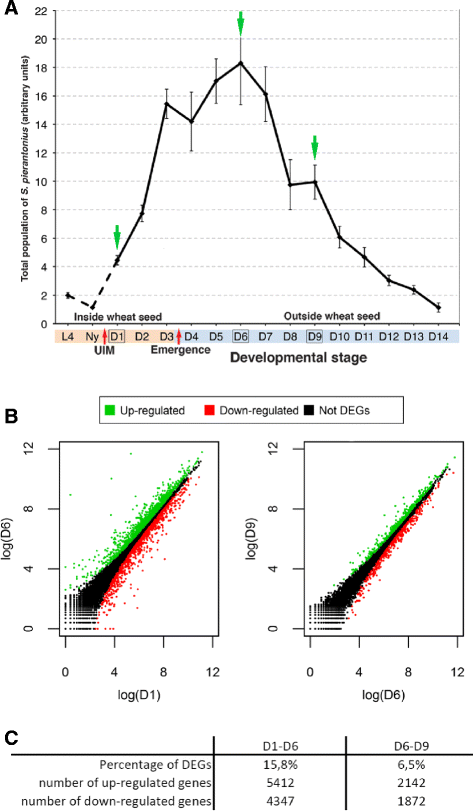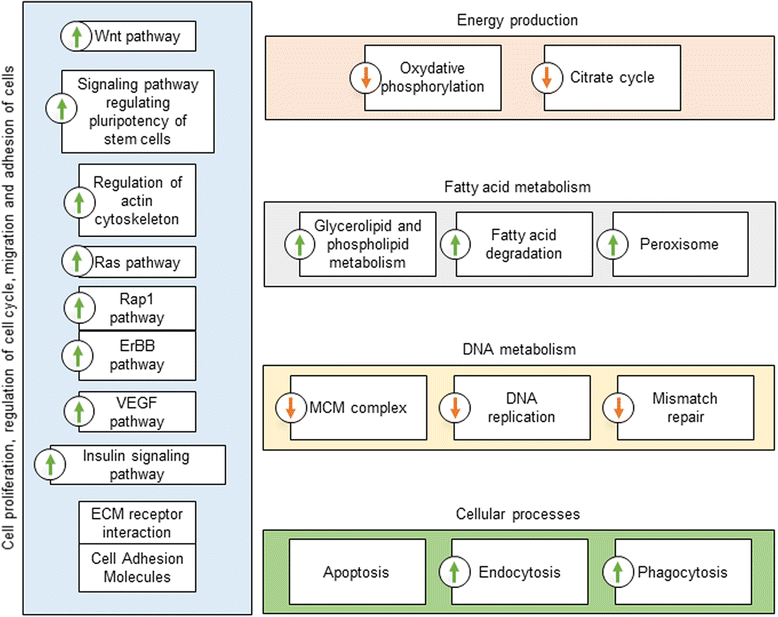Weevil endosymbiont dynamics is associated with a clamping of immunity
- PMID: 26482132
- PMCID: PMC4617454
- DOI: 10.1186/s12864-015-2048-5
Weevil endosymbiont dynamics is associated with a clamping of immunity
Abstract
Background: Insects subsisting on nutritionally unbalanced diets have evolved long-term mutualistic relationships with intracellular symbiotic bacteria (endosymbionts). The endosymbiont population load undergoes changes along with insect development. In the cereal weevil Sitophilus oryzae, the midgut endosymbionts Sodalis pierantonius drastically multiply following adult metamorphosis and rapidly decline until total elimination when the insect achieves its cuticle synthesis. Whilst symbiont load was shown to timely meet insect metabolic needs, little is known about the host molecular and immune processes underlying this dynamics.
Methods: We performed RNA sequencing analysis on weevil midguts at three representative phases of the endosymbiont dynamics (i.e. increase, climax and decrease). To screen genes which transcriptional changes are specifically related to symbiont dynamics and not to the intrinsic development of the midgut, we further have monitored by RT-qPCR sixteen gene transcript levels in symbiotic and artificially non-symbiotic (aposymbiotic) weevils. We also localized the endosymbionts during the elimination process by fluorescence microscopy.
Results: Functional analysis of the host differentially expressed genes by RNA sequencing showed that the main transcriptional changes occur during endosymbiont growth phase and affect cell proliferation, apoptosis, autophagy, phagocytosis, and metabolism of fatty acids and nucleic acids. We also showed that symbiont dynamics alters the expression of several genes involved in insect development. Our results strengthened the implication of apoptosis and autophagy processes in symbiont elimination and recycling. Remarkably, apart from the coleoptericin A that is known to target endosymbionts and controls their division and location, no gene coding antimicrobial peptide was upregulated during the symbiont growth and elimination phases.
Conclusion: We show that endosymbiont dynamics parallels numerous transcriptional changes in weevil developing adults and affects several biological processes, including metabolism and development. It also triggers cell apoptosis, autophagy and gut epithelial cell swelling and delamination. Strikingly, immunity is repressed during the whole process, presumably avoiding tissue inflammation and allowing insects to optimize nutrient recovery from recycled endosymbiont.
Figures





Similar articles
-
Insects recycle endosymbionts when the benefit is over.Curr Biol. 2014 Oct 6;24(19):2267-73. doi: 10.1016/j.cub.2014.07.065. Epub 2014 Sep 18. Curr Biol. 2014. PMID: 25242028
-
An IMD-like pathway mediates both endosymbiont control and host immunity in the cereal weevil Sitophilus spp.Microbiome. 2018 Jan 8;6(1):6. doi: 10.1186/s40168-017-0397-9. Microbiome. 2018. PMID: 29310713 Free PMC article.
-
Host gene response to endosymbiont and pathogen in the cereal weevil Sitophilus oryzae.BMC Microbiol. 2012 Jan 18;12 Suppl 1(Suppl 1):S14. doi: 10.1186/1471-2180-12-S1-S14. BMC Microbiol. 2012. PMID: 22375912 Free PMC article.
-
Insect immune system maintains long-term resident bacteria through a local response.J Insect Physiol. 2013 Feb;59(2):232-9. doi: 10.1016/j.jinsphys.2012.06.015. Epub 2012 Jul 4. J Insect Physiol. 2013. PMID: 22771302 Review.
-
Antimicrobial peptides and cell processes tracking endosymbiont dynamics.Philos Trans R Soc Lond B Biol Sci. 2016 May 26;371(1695):20150298. doi: 10.1098/rstb.2015.0298. Philos Trans R Soc Lond B Biol Sci. 2016. PMID: 27160600 Free PMC article. Review.
Cited by
-
Host-Endosymbiont Genome Integration in a Deep-Sea Chemosymbiotic Clam.Mol Biol Evol. 2021 Jan 23;38(2):502-518. doi: 10.1093/molbev/msaa241. Mol Biol Evol. 2021. PMID: 32956455 Free PMC article.
-
Weevil Carbohydrate Intake Triggers Endosymbiont Proliferation: A Trade-Off between Host Benefit and Endosymbiont Burden.mBio. 2023 Apr 25;14(2):e0333322. doi: 10.1128/mbio.03333-22. Epub 2023 Feb 13. mBio. 2023. PMID: 36779765 Free PMC article.
-
Study of tyramine-binding mechanism and insecticidal activity of oil extracted from Eucalyptus against Sitophilus oryzae.Front Chem. 2022 Sep 23;10:964700. doi: 10.3389/fchem.2022.964700. eCollection 2022. Front Chem. 2022. PMID: 36212071 Free PMC article.
-
Spatial and morphological reorganization of endosymbiosis during metamorphosis accommodates adult metabolic requirements in a weevil.Proc Natl Acad Sci U S A. 2020 Aug 11;117(32):19347-19358. doi: 10.1073/pnas.2007151117. Epub 2020 Jul 28. Proc Natl Acad Sci U S A. 2020. PMID: 32723830 Free PMC article.
-
Endosymbiont Tremblaya phenacola influences the reproduction of cotton mealybugs by regulating the mechanistic target of rapamycin pathway.ISME J. 2024 Jan 8;18(1):wrae052. doi: 10.1093/ismejo/wrae052. ISME J. 2024. PMID: 38519099 Free PMC article.
References
-
- Heddi A. Endosymbiosis in the weevil of genus Sitophilus: genetic, physiological and molecular interactions among associated genomes. In: Bourtzis K, Miller A, editors. Insect Symbiosis. New-York: CRC Press LLC; 2003. pp. 67–82.
-
- Koga R, Tsuchida T, Fukatsu T. Changing partners in an obligate symbiosis: a facultative endosymbiont can compensate for loss of the essential endosymbiont Buchnera in an aphid. Proceedings Biological Sciences/The Royal Society. 2003;270(1533):2543–50. doi: 10.1098/rspb.2003.2537. - DOI - PMC - PubMed
Publication types
MeSH terms
Substances
LinkOut - more resources
Full Text Sources
Other Literature Sources

